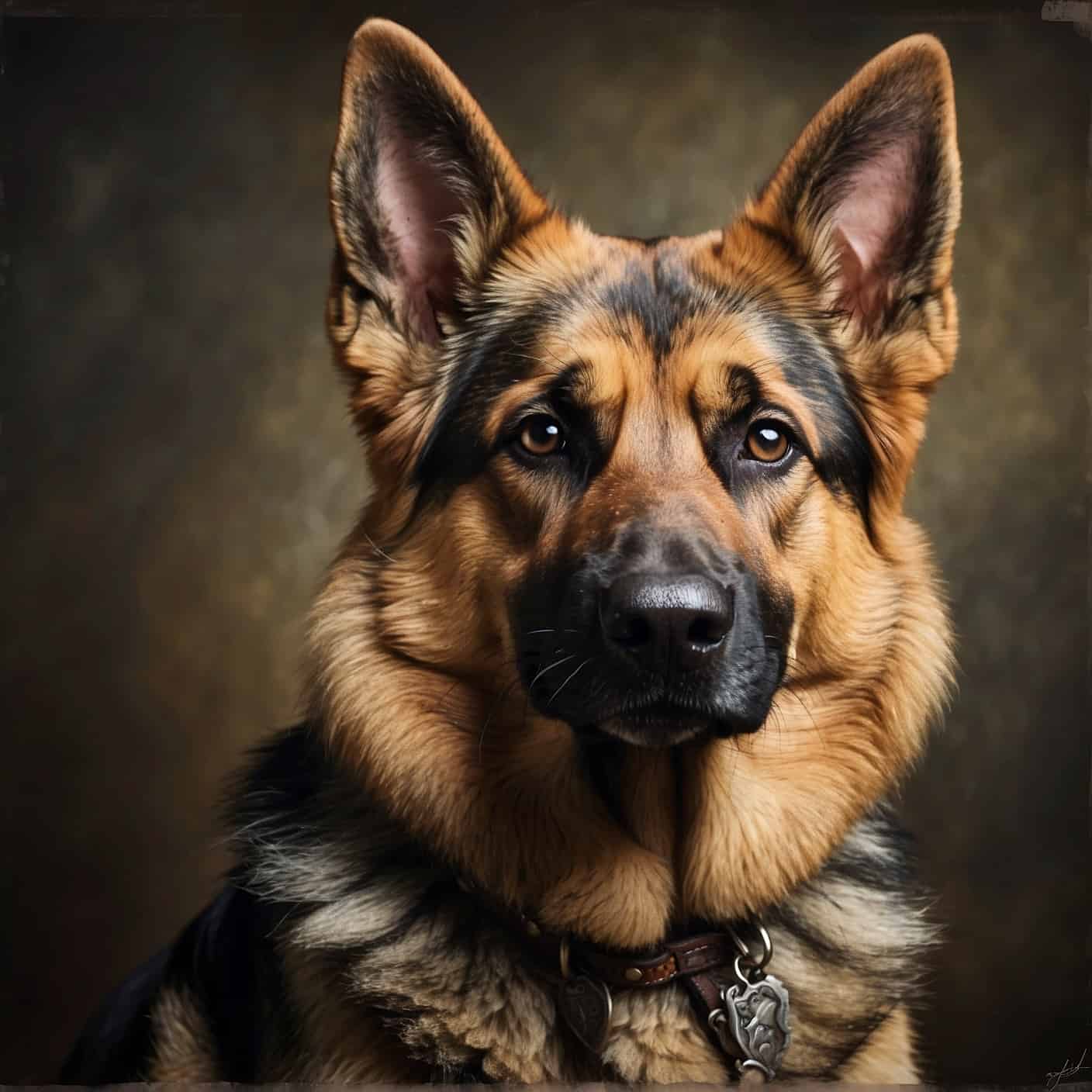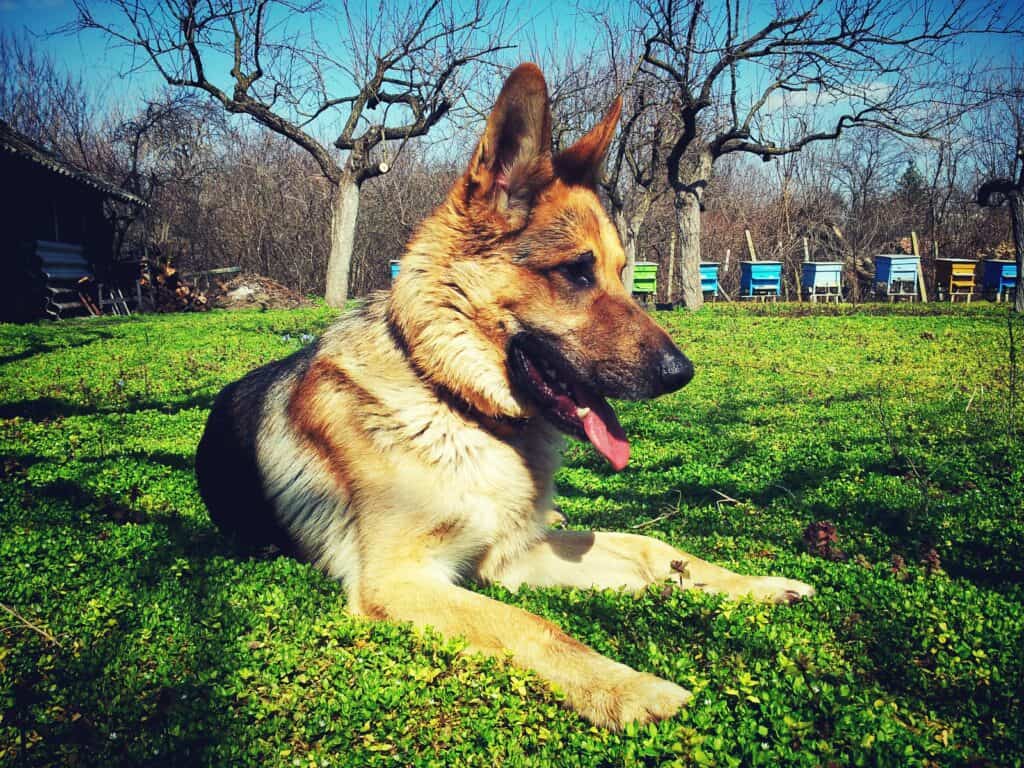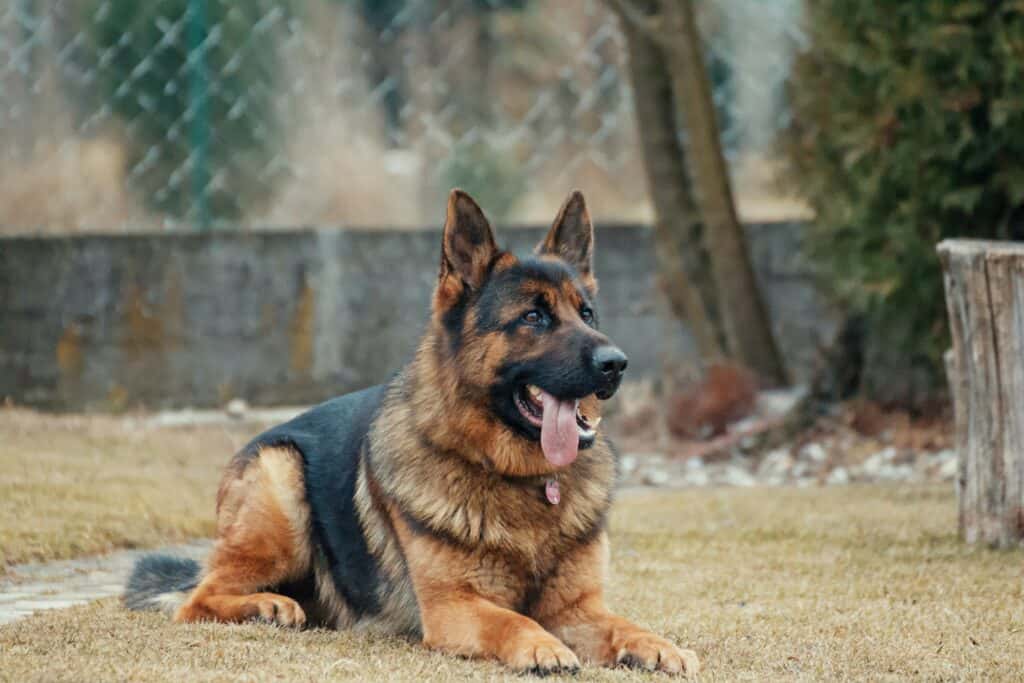The German Shepherd, an embodiment of intelligence, unwavering devotion, and remarkable versatility, has captured the admiration of dog lovers and enthusiasts of various pursuits. With a heritage deeply connected to its origins as a herding and working dog, distinctive physical features, and an array of characteristic traits, this breed has cemented its status as a cherished companion and indispensable working partner.

|
|---|
Woof Mastery is reader supported and our articles may contain affiliate links.
Instead of running third party ads that we have no control of we only use links from high-quality companies we are directly partnered with. Making use of these links come at no cost to you our reader, and in many cases have the extra benefit of discounted rates or sign up bonuses.
If you’re interested you can read more about our affiliate policy here.
We appreciate your support and always insure that the products and services we recommend are high-quality, helpful and relevant to the subject at hand!
The history of the German Shepherd is a tale of remarkable partnership and breeding innovation. In the late 19th century, a German cavalry officer named Max von Stephanitz set out to create an ideal herding and working dog. He aimed to develop a breed with unmatched intelligence, loyalty, and versatility.
Von Stephanitz’s vision materialized in a dog named Horand von Grafrath, the first registered German Shepherd. These canines quickly proved their worth, excelling in herding, search and rescue, and as police and military dogs.
Over time, German Shepherds gained international acclaim for their courage and intelligence. They played pivotal roles in both World Wars and became synonymous with police work and service to humanity. Today, German Shepherds are celebrated for their unwavering loyalty, versatility, and dedication to their human companions.

What sets the German Shepherd apart is its remarkable combination of intelligence and versatility. These dogs are known for their keen problem-solving skills and adaptability, making them excel in various roles, from police and military work to search and rescue missions.
Yet, beyond their exceptional working abilities, German Shepherds are also beloved for their unwavering loyalty. They form deep bonds with their human families and are often described as fiercely protective and gentle companions, especially with children.
With a history deeply rooted in their commitment to service and companionship, German Shepherds epitomize the ideal blend of intelligence, versatility, and devotion, making them truly special among dog breeds.
The German Shepherd’s traditional role in human society is deeply rooted in their herding and working capabilities. Originating as herding dogs in Germany, they excelled at managing and safeguarding livestock. As time passed, their intelligence, loyalty, and versatile skill set made them invaluable in various roles, such as police, search and rescue, and military work. Today, they continue to serve as exceptional working dogs, loyal companions, and reliable protectors of both homes and public safety.
German Shepherds are renowned for their exceptional personalities. They are known for being highly intelligent, loyal, and protective companions. These dogs have a strong work ethic and an unwavering dedication to their families.
Their intelligence and trainability make them quick learners, always eager to please their owners. While they may have a protective nature, they are also known for their gentle and affectionate side, especially with children. German Shepherds are characterized by their confidence, courage, and a deep sense of responsibility. With the right guidance and socialization, they become loyal and loving family members, epitomizing the ideal blend of intelligence and devotion.
German Shepherds are known for their intelligence, loyalty, and courage. They are confident and fearless, often excelling in various roles, from working dogs to family companions.
While they are affectionate with their families, they can be reserved with strangers, making them excellent protectors. Proper training and socialization are vital to ensure their protective instincts are well-balanced and not overprotective.
German Shepherds are medium to large-sized dogs with a well-proportioned and athletic build. They have a strong, square-shaped head with a well-defined forehead and a straight, powerful muzzle. Their expressive eyes are typically dark and almond-shaped. Ears are pointed and stand erect.
They have a double coat with a dense, straight, and weather-resistant outer coat. Coat colors can include black and tan, sable, or solid black. Their tail is bushy and typically hangs down. Males stand between 24 to 26 inches (61-66 cm) at the shoulder and weigh between 65 to 90 pounds (29-41 kg), while females are slightly smaller and lighter.
German Shepherds have a graceful and agile appearance, exuding strength, confidence, and intelligence.
German Shepherds come in a range of colors, including:
German Shepherds may exhibit various coat patterns, including:
1. Bicolor: A predominantly black coat with tan markings on the legs, chest, face, and paws.
2. Saddle Back: A black saddle-like pattern on the back with tan or red markings on the rest of the body.
3. Solid: An entirely black coat or entirely sable with no distinct pattern.
German Shepherds have a moderate shedding level. They shed year-round, with increased shedding during seasonal changes, typically in the spring and fall. Regular grooming and brushing once or twice a week can help manage shedding and maintain a healthy coat.
German Shepherds have a double coat that requires regular grooming to keep it healthy and minimize shedding. Grooming habits for this breed include:
1. Brushing: Regular brushing, at least once or twice a week, is essential to remove loose fur and prevent matting. Use an undercoat rake or slicker brush for thorough grooming.
2. Bathing: German Shepherds do not need frequent baths. Bathe them when necessary using a dog-specific shampoo, and rinse thoroughly.
3. Ears: Check and clean their ears regularly to prevent wax buildup or infections using a veterinarian-recommended ear cleaning solution.
4. Nails: Trim their nails to a comfortable length to maintain proper gait and prevent discomfort.
5. Teeth: Practice dental hygiene by brushing their teeth regularly to prevent dental issues and bad breath. Dental chews or toys can be beneficial.
6. Tail and Paw Care: Pay attention to the tail and paw areas, ensuring they are clean and inspecting for any signs of irritation or injury.
German Shepherds have a high activity level and thrive on physical and mental challenges. Key points about their activity level include:
1. Exercise Needs: German Shepherds require daily exercise to stay healthy and happy. Activities can include long walks, runs, and interactive play.
2. Energy Level: They are known for their high energy levels, which need to be properly channeled through physical and mental stimulation.
3. Working Heritage: Historically, German Shepherds were bred for herding and guarding tasks. They excel in activities like obedience training, agility, and herding.
4. Mental Stimulation: In addition to physical exercise, mental stimulation through training and puzzle games is essential to keep them engaged.
5. Outdoor Enthusiasts: They enjoy outdoor activities and make excellent companions for hikers and runners.
Belgian Malinois are extremely intelligent dogs, known for their exceptional cognitive abilities. Here are some key points about their intelligence:
Belgian Malinois’ exceptional intelligence and work ethic make them excel in challenging roles. They require rigorous training, socialization, and mental stimulation to thrive.
German Shepherds are highly intelligent and require mental stimulation. Engage them in activities like obedience training, puzzle toys, and interactive games to keep their minds sharp.
Social Interaction: They are social dogs and need regular interaction with their human family. Loneliness can lead to anxiety or depression, so provide companionship and attention.
Exercise: Mental exercise is equally important. Offer them tasks that challenge their problem-solving skills.
Training and Obedience: German Shepherds thrive on obedience training, which not only stimulates their minds but also strengthens their bond with their owners. Consistent, positive-reinforcement training is effective in shaping their behavior.
Enter The Woof Mastery

Before bringing a German Shepherd into your home, consider the following:
1. Active Lifestyle: German Shepherds are highly active dogs that require regular exercise and mental stimulation. Be prepared for daily activities.
2. Training Commitment: They are intelligent but need consistent training and socialization to be well-behaved. Consider obedience classes.
3. Space: German Shepherds are medium to large dogs, so make sure you have enough space for them to move around comfortably.
4. Shedding: They shed year-round, so grooming and cleaning up after them is necessary.
5. Health Concerns: Be aware of potential health issues like hip and elbow dysplasia. Regular veterinary check-ups are essential.
German Shepherds, like any large and powerful breed, have the potential to pose a physical risk to others if not properly socialized, trained, or managed. The risk assessment factors include:
1. Protective Instinct: German Shepherds may have a strong protective instinct, especially towards their family or territory. Proper training can help control this instinct.
2. Socialization: Early and thorough socialization is crucial to ensure German Shepherds are comfortable around people and other animals. Poorly socialized dogs may exhibit fear or aggression.
3. Training: Obedience training is essential to teach German Shepherds appropriate behavior and ensure they respond to commands. Well-trained dogs are less likely to engage in aggressive behavior.
4. Owner Responsibility: Responsible ownership involves being vigilant and aware of the dog’s behavior, especially in public settings.
5. Breed-Specific Legislation (BSL): In some areas, German Shepherds may be subject to breed-specific legislation due to their size and strength. Owners should be informed about local laws and regulations.
6. Individual Variability: Each dog is unique, and behavior can vary. Responsible ownership, proper training, and socialization are essential to minimize the potential physical risk to others.
German Shepherds are often excellent family dogs and can be very good with kids. They are protective, loyal, and often form strong bonds with children. These dogs are known for their intelligence and can be gentle, patient, and tolerant, making them great companions for kids when properly socialized and trained.
German Shepherds are generally capable swimmers. They have a strong and muscular build, which allows them to stay buoyant in the water. Many German Shepherds may enjoy being in the water and can paddle and stay afloat. However, the comfort level with swimming can vary among individuals, so it’s important to gauge your dog’s abilities and supervise them in the water.
Remember, early training and positive reinforcement will help your German Shepherd puppy become a well-behaved and loyal companion.
German Shepherds are known to be moderate to high in terms of noisiness. They may bark to alert their owners, and their protective instincts can lead to occasional vocalization, especially in response to perceived threats or unfamiliar situations.
German Shepherds thrive in homes that provide:
Challenges:
When traveling with German Shepherds, consider the following:
German Shepherds are generally healthy, but they can be prone to certain health issues, including:
Proper nutrition is vital for German Shepherds. Follow these nutritional habits:
Proper nutrition is essential for the health and well-being of German Shepherds.
Breed-specific laws (BSL) may impact German Shepherds in certain areas, with regulations varying by jurisdiction. Common BSL restrictions may include:
BSL aims to address perceived risks and public safety concerns associated with certain breeds, including German Shepherds. Advocates of responsible ownership and education argue that breed-specific restrictions may not effectively address individual dog behavior.
To ascertain if BSL affects German Shepherds in your locality, consult local animal control or government authorities to ensure compliance with any applicable regulations.
Woof Mastery is reader supported and our articles may contain affiliate links.
Instead of running third party ads that we have no control of we only use links from high-quality companies we are directly partnered with. Making use of these links come at no cost to you our reader, and in many cases have the extra benefit of discounted rates or sign up bonuses.
If you’re interested you can read more about our affiliate policy here.
We appreciate your support and always insure that the products and services we recommend are high-quality, helpful and relevant to the subject at hand!
Myth 1: German Shepherds are Aggressive Dogs
Truth: German Shepherds’ temperament varies, but they are not inherently aggressive. Proper training and socialization can lead to well-behaved, friendly dogs.
Myth 2: They are Only Police or Guard Dogs
Truth: While they excel in police and guard roles, German Shepherds make excellent family pets, too. They are versatile and adaptable to various activities.
German Shepherds have been featured in various famous roles, including:
These famous German Shepherds have contributed to the breed’s recognition and popularity, both in the entertainment industry and in their working roles.
German Shepherds have been owned and admired by various historical figures and organizations. Notable historical owners include:
German Shepherds, like all breeds, face certain challenges and dangers. Some of the greatest dangers and concerns for the breed include:
By understanding these challenges and providing responsible ownership and care, many of these dangers can be mitigated to ensure the well-being of German Shepherds.
The German Shepherd is a distinct breed known for its versatility and intelligence. It originated in Germany in the late 19th century. Captain Max von Stephanitz played a crucial role in standardizing the breed. The German Shepherd likely developed from various herding and working dogs in Germany. Influences may include local herding breeds, as well as sheepdogs and farm dogs from the region.
The German Shepherd is a versatile and intelligent breed celebrated for its loyalty, courage, and working capabilities. Whether serving as police and military dogs, search and rescue heroes, or cherished companions, German Shepherds consistently prove their worth.
Owning a German Shepherd means embracing their active lifestyle, training requirements, and affectionate nature. Responsible ownership includes addressing potential health concerns and nurturing their protective instincts with proper socialization.
With a legacy rooted in herding and protection, German Shepherds stand as iconic symbols of dedication, making them a favorite choice among dog enthusiasts worldwide.